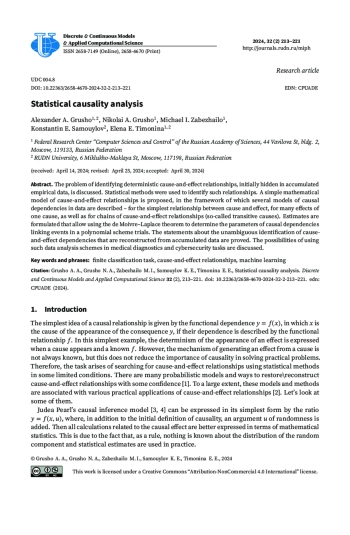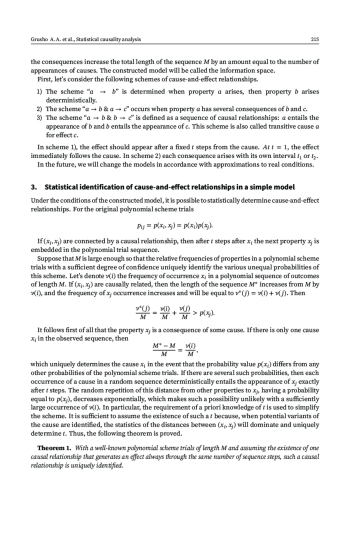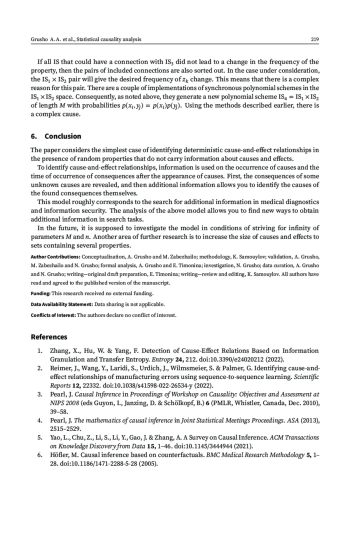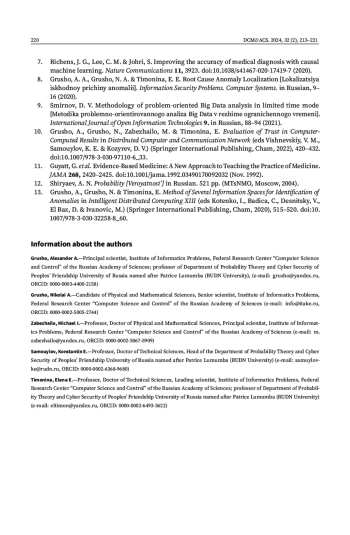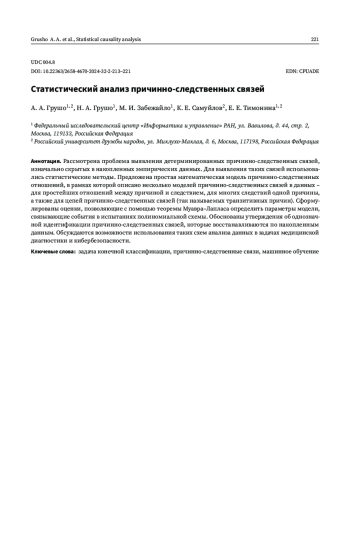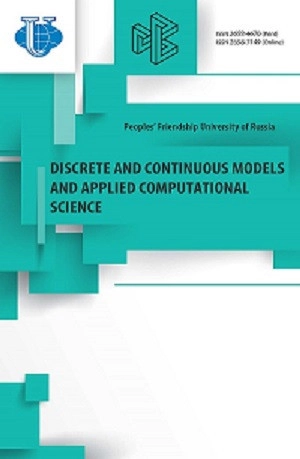The problem of identifying deterministic cause-and-effect relationships, initially hidden in accumulated empirical data, is discussed. Statistical methods were used to identify such relationships. A simple mathematical model of cause-and-effect relationships is proposed, in the framework of which several models of causal dependencies in data are described – for the simplest relationship between cause and effect, for many effects of one cause, as well as for chains of cause-and-effect relationships (so-called transitive causes). Estimates are formulated that allow using the de Moivre–Laplace theorem to determine the parameters of causal dependencies linking events in a polynomial scheme trials. The statements about the unambiguous identification of causeandeffect dependencies that are reconstructed from accumulated data are proved. The possibilities of using such data analysis schemes in medical diagnostics and cybersecurity tasks are discussed.
Идентификаторы и классификаторы
The simplest idea of a causal relationship is given by the functional dependence
Список литературы
1. Zhang, X., Hu, W. & Yang, F. Detection of Cause-Effect Relations Based on Information Granulation and Transfer Entropy. Entropy 24, 212. doi:10.3390/e24020212 (2022).
2. Reimer, J., Wang, Y., Laridi, S., Urdich, J., Wilmsmeier, S. & Palmer, G. Identifying cause-andeffect relationships of manufacturing errors using sequence-to-sequence learning. Scientific Reports 12, 22332. doi:10.1038/s41598-022-26534-y (2022).
3. Pearl, J. Causal Inference in Proceedings of Workshop on Causality: Objectives and Assessment at NIPS 2008 (eds Guyon, I., Janzing, D. & Schölkopf, B.) 6 (PMLR, Whistler, Canada, Dec. 2010), 39–58.
4. Pearl, J. The mathematics of causal inference in Joint Statistical Meetings Proceedings. ASA (2013), 2515–2529.
5. Yao, L., Chu, Z., Li, S., Li, Y., Gao, J. & Zhang, A. A Survey on Causal Inference. ACM Transactions on Knowledge Discovery from Data 15, 1–46. doi:10.1145/3444944 (2021).
6. Höfler, M. Causal inference based on counterfactuals. BMC Medical Research Methodology 5, 1– 28. doi:10.1186/1471-2288-5-28 (2005).
7. Richens, J. G., Lee, C. M. & Johri, S. Improving the accuracy of medical diagnosis with causal machine learning. Nature Communications 11, 3923. doi:10.1038/s41467-020-17419-7 (2020).
8. Grusho, A. A., Grusho, N. A. & Timonina, E. E. Root Cause Anomaly Localization [Lokalizatsiya iskhodnoy prichiny anomalii]. Information Security Problems. Computer Systems. in Russian, 9– 16 (2020).
9. Smirnov, D. V. Methodology of problem-oriented Big Data analysis in limited time mode [Metodika problemno-orientirovannogo analiza Big Data v rezhime ogranichennogo vremeni]. International Journal of Open Information Technologies 9. in Russian, 88–94 (2021).
10. Grusho, A., Grusho, N., Zabezhailo, M. & Timonina, E. Evaluation of Trust in Computer- Computed Results in Distributed Computer and Communication Network (eds Vishnevskiy, V. M., Samouylov, K. E. & Kozyrev, D. V.) (Springer International Publishing, Cham, 2022), 420–432. doi:10.1007/978-3-030-97110-6_33.
11. Guyatt, G. et al. Evidence-Based Medicine: A New Approach to Teaching the Practice of Medicine. JAMA 268, 2420–2425. doi:10.1001/jama.1992.03490170092032 (Nov. 1992).
12. Shiryaev, A. N. Probability [Veroyatnost’] in Russian. 521 pp. (MTsNMO, Moscow, 2004).
13. Grusho, A., Grusho, N. & Timonina, E. Method of Several Information Spaces for Identification of Anomalies in Intelligent Distributed Computing XIII (eds Kotenko, I., Badica, C., Desnitsky, V., El Baz, D. & Ivanovic, M.) (Springer International Publishing, Cham, 2020), 515–520. doi:10. 1007/978-3-030-32258-8_60.
Выпуск
Другие статьи выпуска
In recent years, artificial intelligence methods have been developed in various fields, particularly in education. The development of computer systems for student learning is an important task and can significantly improve student learning. The development and implementation of deep learning methods in the educational process has gained immense popularity. The most successful among them are models that consider the multimodal nature of information, in particular the combination of text, sound, images, and video. The difficulty in processing such data is that combining multimodal input data by different channel concatenation methods that ignore the heterogeneity of different modalities is an inefficient approach. To solve this problem, an inter-channel attention module is proposed in this paper. The paper presents a computer vision-linguistic system of student learning process based on the concatenation of multimodal input data using the inter-channel attention module. It is shown that the creation of effective and flexible learning systems and technologies based on such models allows to adapt the educational process to the individual needs of students and increase its efficiency.
A number of initial boundary-value problems of classical mathematical physics is generally represented in the linear operator equation and its well-posedness and causality in a Hilbert space setting was established. If a problem has a unique solution and the solution continuously depends on given data, then the problem is called well-posed. The independence of the future behavior of a solution until a certain time indicates the causality of the solution. In this article, we established the well-posedness and causality of the solution of the evolutionary problems with a perturbation, which is defined by a quadratic form. As an example, we considered the coupled system of the heat and Maxwell’s equations (the microwave heating problem).
The article describes a method for calculating interpolation coefficients of expansion using Chebyshev polynomials. The method is valid when the desired function is bounded and has a finite number of maxima and minima in a finite domain of interpolation. The essence of the method is that the interpolated desired function can be represented as an expansion in Chebyshev polynomials; then the expansion coefficients are determined using the collocation method by reducing the problem to solving a well-conditioned system of linear algebraic equations for the required coefficients. Using the well-known useful properties of Chebyshev polynomials can significantly simplify the solution of the problem of function interpolation. A technique using the Clenshaw algorithm for summing the series and determining the expansion coefficients of the interpolated function, based on the discrete orthogonality of Chebyshev polynomials of the 1st kind, is outlined.
As the standardization of 5G New Radio (NR) systems operating in micro- and millimeter-wave frequency bands is over, scientific and industrial communities have begun to address the question of what 6G communications systems might or should be. While technological specifics are still in their early development phase, there is a common agreement that these systems will utilize the lower part of the terahertz band, namely, 100–300 GHz. This band poses a number of specific challenges for system designers, including the effects related to channel characteristics and the conceptually new requirements for electronics. This paper aims to report the current state-of-the-art channel characterization and communications system design. With respect to the former, we consider dynamic human body blockages and micromobility impairments. For the latter, we mainly concentrate on the physical layer devices for direct conversion schemes and the design of the so-called reconfigurable intelligent surfaces that will potentially serve as a cost-efficient blockage mitigation technique.
We introduce a numerical method to solve the two-dimensional time-dependent Schrödinger equation, which characterizes a system of two atoms with a finite-range interaction potential confined within a harmonic oscillator trap. We choose a Gaussian-shaped potential for the interaction potential. Such a system has been previously studied analytically, except that a zero-range interaction potential was used instead. We observe a strong agreement between the results for the two types of interactions. Also, we investigate the one-dimensional time-dependent Schrödinger equation for the relative motion and compute the ground state energy level as a function of the coupling strength.
This work is the first part of a large bibliographic review of active queue management algorithms of the Random Early Detection (RED) family, presented in the scientific press from 1993 to 2023. The third part will provide data on algorithms published from 2016 to 2023.
In the paper, a retrial queueing system of
We describe the system of ethical disclaimers being introduced in the journal.
Статистика статьи
Статистика просмотров за 2025 год.
Издательство
- Издательство
- РУДН
- Регион
- Россия, Москва
- Почтовый адрес
- 117198, г. Москва, ул. Миклухо-Маклая, д. 6
- Юр. адрес
- 117198, г Москва, Обручевский р-н, ул Миклухо-Маклая, д 6
- ФИО
- Ястребов Олег Александрович (РЕКТОР)
- E-mail адрес
- rector@rudn.ru
- Контактный телефон
- +7 (495) 4347027
- Сайт
- https://www.rudn.ru/

